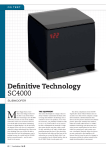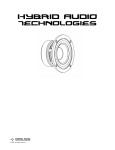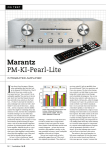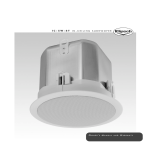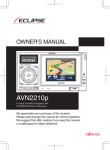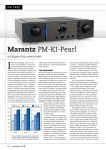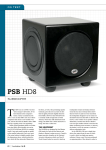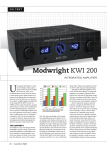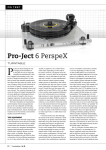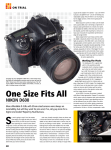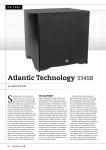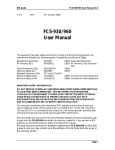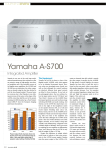Download HF Nov12_020 Test Sunfire.indd
Transcript
ON TEST Sunfire Atmos SUBWOOFER I really don’t think I am ever likely to see a subwoofer smaller than Sunfire’s new Atmos. It’s so small I was very tempted to ask the photographer to put a matchbox alongside it to give you a sense of scale! But to give you an idea, the Sunfire Atmos is small enough to fit inside a basketball! But it’s not only small. It’s also packed with technology, including a compressor, soft-clipping and automatic room calibration circuitry. THE EQUIPMENT You can’t really miss the fact that there are two drivers on the Sunfire Atmos, except that one isn’t a driver: it’s a passive radiator. When you’re looking at the rear panel, the Sunfire Atmos’ driver is on the right hand side of the subwoofer. It’s driven by an amplifier inside the Atmos that Sunfire rates as having an output of 1,400-watts (into 3.3Ω). This driver’s overall diameter is 183mm, but its Thiele/Small diameter is 137mm. The actual ‘cone’ diameter is 100mm but I put the word cone in inverted commas because there really 20 Australian isn’t a cone as such: the driving element is completely flat. The driver itself is even more unusual, because the material used as the flexible surround extends all over the driver, so there is not the usual ‘join’ between the surround and the cone. I assume that there’s a stiff, flat circular plate underneath, and it’s this that’s attached to the voice-coil former, but I couldn’t remove the driver to check. Sunfire itself says of the design that: ‘An extralarge magnet and long-throw mechanical design yield very high back-emf. The result is extraordinarily high operating efficiency—that is, more acoustic output for each watt of input.’ This high back-emf is significant, according to Sunfire, because it means that the current flowing in the voice-coil is lower that it would otherwise be which, in the company’s words: ‘is the singular property of the driver that allows the subwoofer to be approximately ten times more efficient that a subwoofer this size would normally be.’ However, even with high back-emf limiting current flow in the circuit, using an amplifier capable of delivering 1,400-watts means that Sunfire has had to include sophisticated protection circuitry to prevent damage to the driver in the event that some unwitting consumer does something silly. The first line of defence is a compressor circuit that kicks in if the input signal level reaches a voltage that would overload the driver. If the input signal level exceeds the capability of the compressor to control it, the Atmos’ second line of defence is a soft-clipping circuit that Sunfire says allows high volume levels but prevents poling—or to use Sunfire’s exact words: ‘produces extremely high sound pressure levels in your room without the driver banging against the mechanical stops.’ The passive radiator (which is on the left side of the Atmos, when you’re looking at it from the back) looks identical to the driven ‘cone’, but of course it does not have a magnet or voice coil and is not connected to the amplifier. It’s driven simply by variations in air pressure inside the cabinet that are caused by the movement of the driven Sunfire Atmos Subwoofer ON TEST SUNFIRE ATMOS SUBWOOFER ‘cone’ on the opposite wall. This is why this particular type of driver is often referred to as a ‘drone cone.’ The first thing I noticed on the rear panel was that the Atmos doesn’t have speaker level inputs, but I guess that given the small amount of space available, this would have been difficult without providing some form of custom connector. However, I also noticed three pairs of gold-plated RCA terminals, which was also unusual. It turned out that the top-most pair is for left/right line level input (also LFE). The pair underneath can be used to ‘copy’ the signal that’s presented at the line-level inputs, or it can be used to send a high-pass filtered (at 85Hz) further down your signal chain. Essentially, this connection allows you to relieve your main front loudspeakers of the responsibilities for handling low-frequency signals… at least frequencies below 85Hz. However, in practise, you would ONLY use this if your speakers were not capable of handling signals below 85Hz (which would be all small bookshelf loudspeakers). The third set of RCA terminals—the bottom-most pair—are labelled ‘Slave Input’ and ‘Slave Output’. They’re designed to simplify operation when you are using more than one Atmos subwoofer. Why would you use more than one Atmos? The main reason is that the output of a subwoofer (any subwoofer) is hugely affected by a room’s acoustics, so it’s entirely possible that depending on where you position a subwoofer in your room, there may be certain locations in that room where you will hear almost no sound at all at certain frequencies. This is not a fault with the subwoofer, it’s simply that reflections from the walls and other surfaces of your room cancel those frequencies. The ONLY way to correct this (other than rebuilding your room) is to add a second subwoofer and place it in a different physical location in the room, such that its output will ‘fill-in’ the dead spots where the other subwoofer’s output has been cancelled. Many acoustics experts right around the world— including the famous speaker researcher Floyd E. Toole—have long championed the use of multiple subwoofers in the home environment, but their sage advice hasn’t gained much traction, probably because so few people like having even a single subwoofer in their home that the chance of talking people into having two subwoofers in the same room is incredibly small. However, that’s because most subwoofers are very large, and it’s only really their size that people object to. The size of the Sunfire Atmos means that, finally, it will be possible to place two (or even more!) subwoofers in the same room without them intruding physically—or visually—on domestic living arrangements (aka décor!). The Slave input/outputs are configured in such a way that when you add a second Atmos subwoofer, there’s no need to adjust the controls on the second subwoofer— any adjustments you make to the controls of the main subwoofer will be automatically be sent to the ‘slave’ subwoofer. Brand: Sunfire Model: Atmos Category: Powered Subwoofer RRP: $1,999 Warranty: Three Years Distributor: Audio Products Pty Ltd Address: Level 1, 67 O’Riordan Street Alexandria NSW 2015 1300 134 400 [email protected] www.audioproducts.com.au • Small size • Room correction circuitry • Flat response • Calibration process • Lack of grilles LAB REPORT Readers interested in a full technical appraisal of the performance of the Sunfire Atmos XTATM265230 Powered Subwoofer should continue on and read the LABORATORY REPORT published on page 114. Readers should note that the results mentioned in the report, tabulated in performance charts and/ or displayed using graphs and/ or photographs should be construed as applying only to the specific sample tested. Lab Report on page 114 avhub.com.au 21 ON TEST Sunfire Atmos Subwoofer Above the RCA input/output panel is a subpanel that houses a crossover frequency control (adjustable between 30Hz and 100Hz, with a reference marking at 65Hz and a ‘Bypass’ setting at its most clockwise setting), a level control (‘Min’ to ‘Max’ with no intermediate calibration markings) and a Phase control (0° to 180°, with an intermediate calibration at 90°). All three controls are rotary, with a silky-smooth action (that is, they’re not click-stop types). Also in this subpanel is a tiny 2.5mm phone jack labelled ‘Mic Input’, a tiny red ‘Start’ pushbutton, a chameleon LED marked ‘EQ’ and a two-position slider switch with positions for EQ Off and EQ On. All are involved with the automatic room equalisation circuitry I mentioned previously. The necessary measurement microphone is supplied with the Atmos, and Sunfire also provides a really (really!) nice little microphone stand. Towards the bottom of the rear panel is a mains power switch and a standard threepin IEC 240V mains power socket. Although there’s only the single power switch, the Atmos has automatic power circuitry that switches the subwoofer on when an audio signal is detected and off again when there hasn’t been an audio signal for around five minutes. This is a long enough delay that you’re unlikely to have any false ‘off’ triggers. However, speaking of triggers, the Atmos also has a 12V d.c. turn-on trigger to allow integration with sophisticated automated home theatre or home audio systems. Did I mention how small the Sunfire Atmos is? It’s just 216mm high, 226mm wide and 257mm deep. Despite these dimensions, it weighs a substantial 14.5kg, so it’s no lightweight! I also haven’t mentioned the full model name of the 230-Volt version of the Sunfire Atmos, because it’s ‘way too long and convoluted. However, for the record, the precise model number of the model I reviewed is the Sunfire Atmos XTATM265230. IN-USE AND LISTENING SESSIONS I have to say right at the outset that I just couldn’t get over the size of the Sunfire Atmos in all the time I was reviewing it. It’s so small that I found that I actually had to position it out of the way in my listening room, because if I didn’t, I—or someone else in my family—would always end up tripping over it! However, thanks to it being so small, it fitted under every piece of furniture in my living room… except the sofa! 22 Australian The first thing I did was position the subwoofer in the best position in my listening room. This in itself is interesting because there are several positions in my room that are acoustically the ‘best’ but until I took the Atmos home for review, not one of these positions was visually acceptable to my better half, so where I have my subwoofers (yes, I take my own advice) has always been a bone of domestic disharmony. The size of the Atmos meant that all of a sudden, I not only had several ‘acoustic best’ positions to put it, but also a choice of ‘visual best’ positions (including ‘not visible at all’). As discussed previously, locating the best position for a subwoofer in the room is fairly complicated, so we’ve loaded the information on our website here: www.tinyurl.com/subwooferplacement. As it happens, the Owners’ Manual that comes with the Atmos gives almost identical advice to that on our website, though Sunfire adds the information that it designed the Atmos to be placed in a corner, and suggests you start your location search with at least two corners before trialling other positions in the room. I was extremely pleased to find that Sunfire also includes advice on how to set the crossover frequency and phase controls except that, rather than re-invent the wheel, the company simply reproduces (with permission) a calibration procedure recommended by Dr David Rich at the time he was a contributing editor to The Audio Critic, a US audio magazine that is no longer published (though it still maintains— somewhat sporadically—a web presence). Rich’s advice is excellent, but does require you to purchase both a test CD and an SPL meter. If you use Rich’s method, you’ll quickly find that it would have helped a lot if Sunfire had provided calibration markings for the level, frequency and phase controls on the Atmos! Sunfire also provides two pages of detailed instructions on how to use the automatic room equalisation circuitry. As you’ve probably guessed from the fact that it takes two pages to describe it, the process isn’t completely automated: it requires a fair bit of button-pushing, and some attention to detail (not to mention some careful listening) on your behalf. Indeed I found that on my In terms of small subwoofers, the Sunfire Atmos sets a new bar for low-frequency performance both in terms of bass extension and clean, undistorted SPLS ON TEST Sunfire Atmos Subwoofer first attempts I could not get the circuitry to work in the way the manual told me it should work. Even more confusing for me was that I could get the circuit to do something completely different, more in line with the calibration procedures used for other subwoofers made by Sunfire. Eventually, after some to-and-froing between myself, the Australian distributor and Sunfire in the USA, which resulted in renewed attempts by yours truly, I finally mastered the process. And, once I had the calibration process down pat, I was able to calibrate the Atmos quickly and easily every time I needed to (you only need to do so when you move the subwoofer), without recourse to the instruction manual, so it was obviously an issue with my understanding the instructions, rather than that of the process or the instructions themselves… and in real life, if you run into problems, you’ll be able to get your friendly local Sunfire dealer to demonstrate the calibration process to you. However, after you have correctly initiated the first step of the process correctly, the second step requires that you be able to hear a tone with a frequency of 35Hz, and that’s something that I suspect some older people (over 65 years of age) will be unable to do—at least at the low level the tone is being generated by the Atmos during the calibration process. So if you fall into this age bracket, I’d suggest that when you’re initiating the calibration process, you should actually watch the driver cone, or feel the cabinet for the tell-tale vibration that will tell you the subwoofer is performing the 35Hz calibration. Additionally, I feel the manual should note that if—as I did when I first tried to calibrate the subwoofer—you hear a frequency sweep (with ascending tones running from low to high) rather than just a single fixed frequency, you should reset the subwoofer (using the reset procedure outlined in the manual) and start all over again. I’ve said it before and I’ll say it again (here and most likely in many future subwoofer reviews) that no matter how much hightech you throw at a subwoofer you will ultimately be bound by the inviolable laws of physics, which dictate that there will always be limits on the sound pressure levels that can be delivered at any particular low frequency—particularly in the sub-bass area. So I really can’t agree with Sunfire’s claim that the Atmos provides (and I quote): ‘as Sets a new standard in linearity: across its performance band, its frequency response is superbly flat much bass as you could get from several 15-inch drivers mounted in a cabinet the size of a small refrigerator’ (unquote). However, how many people do you know who’d buy a subwoofer the size of a small refrigerator, irrespective of how many 15-inch subwoofers might be fitted in it? That said, my jaw did drop when I heard the depth and volume of sound the Sunfire Atmos was able to deliver in my listening room. In terms of small subwoofers, it set a new bar for low-frequency performance, both in terms of its bass extension and as regards the clean, undistorted sound pressure levels it can deliver. It also sets a new standard in linearity: across its performance band, its frequency response is superbly flat, so no one frequency is emphasised at the expense of any others. The lack of distortion also meant that the low bass was remarkably tuneful. Most of the small subwoofers I’ve auditioned previously had such high levels of distortion that it’s difficult to easily follow low-bass lines on instruments such as, for example, an electric bass. So long as I kept the volume at reasonable levels, I had no such difficulties with the Sunfire Atmos. That said, there’s no doubt that the Atmos performs at its best with music when it’s reproducing music that has only two or three instruments in its passband—drums, bass guitar/double bass and electric piano/ synthesizer, for example—just as there’s no doubt it performs better at low to average in-room sound pressure levels than it does at high sound pressure levels. But given the incredibly small size of the Atmos, it’s a wonder that it performs as well as it does. During my auditions I found that my jaw dropped so often—and so far—that it ached! Another reason for the Atmos’ superb performance is that Sunfire has not attempted to over-reach the design, in that it essentially operates only at frequencies lower than 100Hz (around G#2 on a standard piano keyboard), which means that for best integration with main speakers, those speakers should be capable of operating down to at least that frequency. CONCLUSION Did I mention the size of the Sunfire Atmos? And that it sets a new standard for performance for a subwoofer of its size? I certainly know that I raved about its jaw-dropping performance. Basically, the only conclusion I can draw after experiencing it is that if you’re in need of a small subwoofer, for either music or home theatre applications (or both), you really owe it to yourself to check out the Atmos… but do prepare to be amazed! greg borrowman LAB REPORT ON PAGE 114 24 Australian LAB REPORT Sunfire Atmos Subwoofer CONTINUED FROM PAGE 20 TEST RESULTS The frequency response measured by Newport Test Labs of the Sunfire Atmos XTATM265230 was better than the manufacturer claimed, with the top-most (red) trace in Figure 1 showing that it was measured as extending from 28Hz to 129Hz ±3dB. That’s not only better than specification, it’s a truly excellent response for a subwoofer in its own right. As you can see from the trace, the Atmos delivers maximum output at 56Hz, and is so flat This is an impressive and very well-designed subwoofer either side of this frequency that it’s comes in at 37Hz to 90Hz ±1dB! Note that all three traces were measured after the Sunfire’s circuitry had been equalised for flattest response in an IEC listening room environment. Figure 2 and Figure 3 show the nearfield responses of the individual drivers located either side of the Atmos. You can see that one peaks at around 65Hz and the other 10Hz lower, at 55Hz. For this measurement, Newport Test Labs reset the automatic EQ and ran the Atmos in its Bypass mode, so you’re looking at the raw, unequalised responses of the drivers, each time for three different settings of the crossover frequency control: 115 30Hz, 65Hz and 100Hz. It’s clear from these graphs that Sunfire is using the equalisation circuit to attenuate the output of the drivers to produce the best response, which is a far better solution than trying to use additional boost. Figure 4 shows the four test tones generated by Sunfire Atmos’s equalisation circuitry, and you can see, despite the dBSPL Newport Test Labs 115 110 110 105 105 100 100 95 95 90 90 85 85 80 80 75 75 70 70 65 65 60 60 55 55 20 Hz 30 40 50 60 70 80 90 100 200 dBSPL Newport Test Labs 115 110 110 105 105 100 100 95 95 90 90 85 85 80 80 75 75 70 Newport Test Labs 20 Hz 30 40 50 60 70 80 90 100 200 dBSPL Newport Test Labs 70 65 65 60 55 dBSPL Figure 3: Near-field frequency responses - right driver only - with crossover frequency control set at 30Hz (black trace), 65Hz (green) and 100Hz (red). [Sunfire Atmos] Figure 1: Pink noise frequency responses (smoothed) at 2.0 metres with crossover frequency control set at 30Hz (black trace), 65Hz (green) and 100Hz (red). [Sunfire Atmos] 115 low resolution of the filters Newport Test Labs used to isolate the signals, that the tone frequencies are positioned at 35Hz, 48Hz, 62Hz and 80Hz, meaning that the equalisation circuitry will only be able to correct the Atmos’s response at and around these frequencies. This is an impressive and very wellSteve Holding designed subwoofer! 60 20 Hz 30 40 50 60 70 80 90 100 Figure 2: Near-field frequency responses - left driver only - with crossover frequency control set at 30Hz (black trace), 65Hz (green) and 100Hz (red). [Sunfire Atmos] 114 Australian 200 55 20 Hz 30 40 50 60 70 80 90 100 Figure 4. Frequencies of tones generated by equalisation circuit. [Sunfire Atmos Sub] 200






